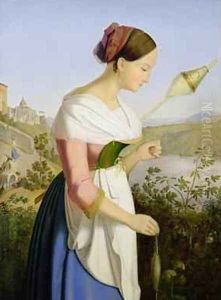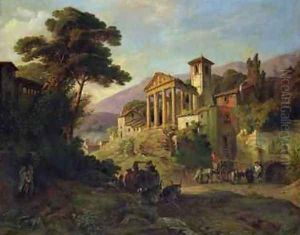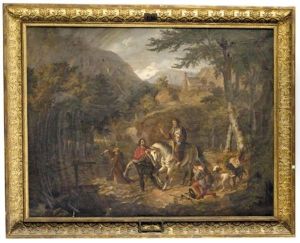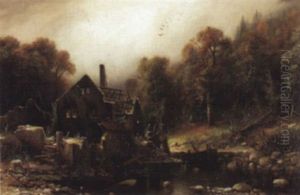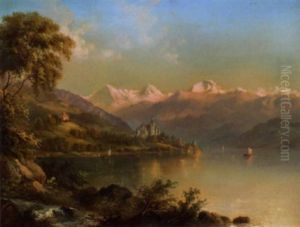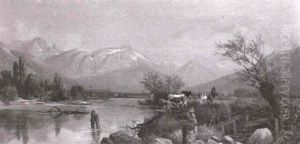Friedrich Wilhelm Mueller Paintings
Friedrich Wilhelm Müller, more commonly known by his pseudonym, Carl Wilhelm Müller or even more so as Wilhelm Müller, was a German painter, not to be confused with the similarly named poet Wilhelm Müller, famous for the texts of Schubert's 'Die schöne Müllerin' and 'Winterreise'. Born in 1818, Wilhelm Müller's exact place of birth within Germany remains less documented, reflecting the era's limited record-keeping and the overshadowing fame of his literary namesake. His life spanned a period of significant political, social, and artistic changes in Germany, encompassing the revolutions of 1848 and the subsequent unification of Germany in 1871 under Prussian leadership.
Müller's artistic journey was deeply influenced by the Romantic movement, which was prevalent in Germany and across Europe during his early years. This movement emphasized emotion, individualism, and a reverence for nature, elements that found their way into Müller's works. He was known for his landscapes and scenes depicting Germanic folklore and rustic life, imbuing his paintings with a sense of national identity and romantic nostalgia that resonated with the burgeoning sense of German nationalism of the time.
Despite the commonality of his name, detailed records of Müller's artistic education and career trajectory are sparse. It is believed that he traveled within Germany and possibly to other parts of Europe for his artistic training and inspiration, a common practice among artists of his time. His works were primarily oils, characterized by their meticulous detail, vibrant colors, and the ability to capture the transient effects of light and atmosphere, hallmarks of the Romantic sensibility.
Over the course of his career, Müller participated in various exhibitions, though his fame did not reach the heights of his contemporaries such as Caspar David Friedrich or Philipp Otto Runge. Nonetheless, his contributions to the German Romantic movement provided a valuable link in the chain of artistic evolution in the 19th century, reflecting the transitional period between the romantic and the burgeoning realist aesthetic that would dominate the latter half of the century.
Wilhelm Müller died in 1887, leaving behind a modest but poignant body of work that continues to be appreciated by art historians and collectors. His paintings, while not as widely recognized as those of some of his peers, offer insightful perspectives on the German landscape, both physical and cultural, of his time. Müller's legacy is that of a skilled artisan who captured the spirit of his age with sensitivity and detail, contributing to the rich tapestry of 19th-century European art.
